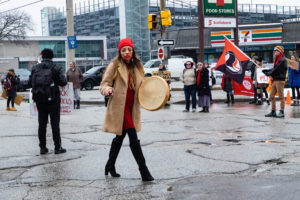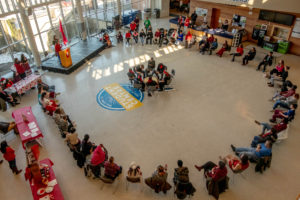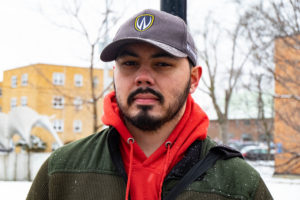Students, faculty show solidarity for Wet’suwet’en with walkout

University of Windsor Faculty of Law student, co-president of Windsor Law’s Shkawbewisag Student Law Society and walkout organizer, Valeria Kuri, attended wearing red face paint and a red dress earring as symbols of the Inquiry into Missing and Murdered Indigenous Women, Girls and Two Spirited People (MMIWG2). Photo by Patrick White.
University of Windsor Faculty of Law student, co-president of Windsor Law’s Shkawbewisag Student Law Society and walkout organizer, Valeria Kuri, attended wearing red face paint and a red dress earring as symbols of the Inquiry into Missing and Murdered Indigenous Women, Girls and Two Spirited People (MMIWG2). Photo by Patrick White.
Students in the University of Windsor’s Faculty of Law staged a walkout Friday Feb. 14 in an act of solidarity with the Wet’suwet’en hereditary chiefs and the Wet’suwet’en hereditary chiefs and Missing and Murdered Indigenous Women, Girls and Two Spirited People.
The walkout occurred on the ninth day of a Tyendinaga Mohawk campout near Belleville, Ont. which has resulted in the forced closure of one of Canada’s major arterial rail lines. Similar protests are being held across the country as a result of the growing sentiment of disapproval for the Royal Canadian Mounted Police’s use of armed force to remove First Nations Peoples from Wet’suwet’en territory under an injunction order. The Supreme Court of British Columbia granted the Coastal Gaslink injunction on Dec. 31 last year.
The faculty walkout and similar protests across the country come after Wet’suwet’en hereditary chiefs filed for a judicial review of the British Columbia Environmental Assessment Office’s (BCEAO) decision to grant a five-year extension of the environmental certificate for the proposed pipeline. The hereditary chiefs filed for this review on the grounds that the BCEAO ignored recent findings of the inquiry on MMIWG as well as “over 50 instances of non-compliance by Coastal Gaslink,” according to the Feb. 3 press release from the Office of the Wet’suwet’en.
“The Inquiry found direct links between extractive industries, ‘man camps,’ and increased violence against Indigenous women,” said the release.

Protesters joined hands and set pylons down at the intersection of Wyandotte and Patricia to barricade traffic coming from the Canada-US border. Photo by Patrick White.
Kuri and event attendees agreed that it is telling that their impromptu walkout coincided with a University of Windsor awareness campaign for MMIWG2. As a part of this campaign, a circle dance honouring MMIWG2 had been planned for the day following the walkout.

The MMIWG2 awareness campaign included a circle dance (shown above), Saturday Feb. 15, a day after the faculty walkout. Photo by Patrick White.
“There’s a huge connection between main camps and colonial violence against Indigenous women,” said Kuri.
The role of social media
Activists across the country have quickly gained momentum on social media by using hashtags such as #WetsuwetenStrong, #AllEyesOnWetsuweten, #handsoffWetseweten, #WetsuwetenSolidarity, #ShutDownCanada and #MMIWG2.
Since the RCMP began enforcing the injunction order, there has been a significant increase in protests emerging across the country. On Feb. 7, only one day after the Mounties were called in, the Tyendinaga Mohawk began the CN line blockade near Belleville.

David Pitawanakwat, who comes from Wiikwemkoong Unseeded Territory said that social media is important to spreading awareness for solidarity events but urges against ‘slacktivism.’ Photo by Patrick White.
“I think there is a big movement today toward slacktivism — to share events and not do anything about it. But we’re not out here to just share events on Facebook, Twitter or Instagram, we’re out here acting on it,” said Pitawanakwat, who was present at the faculty walkout.
Kuri said the event happened overnight. She sent out the official statement and created the Facebook event page just two nights prior to the walkout. The University of Windsor Law faculty walkout saw participation from students, professors as well as non-faculty members, despite the last-minute planning.
Janet Macissac, a PhD student in psychology, showed up for the event, although her faculty was not officially participating.
“We decided to shut down the border in an act of solidarity with other direct actions happening across the country,” said Macissac. “As psychologists we have a commitment to social justice and to our ethical principles and we have to fight back whenever things are like this.”
For Kuri, the event had to be now or never.
“I felt an urgency,” said Kuri. “I had been getting contacted by lots of students and professors not really sure what to do but needing to expel the energy somehow. So I emailed my Indigenous professors asking them what can we do.
“They said to do something now.”
The tone is somber and moving at Uaw Centre round dance honoring missing and murdered indigenous women, girls and 2 spirit folks#MMIWG #YQG #uaw #WetsuwetenSolidarity pic.twitter.com/D1mqArxmV1
— Patrick James White (@PatrickJamesWh5) February 14, 2020
I’m here at the UWindsor faculty of law walkout as organizers get their march underway pic.twitter.com/pbcTBbLM0I
— Patrick James White (@PatrickJamesWh5) February 13, 2020


